science
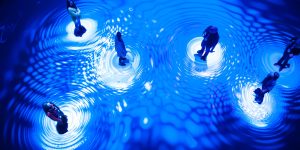
Quantum Logos
Mark Chavez (US), Ina Conradi (SG), Tate Chavez (US), Bianka Hofmann (DE), Bob Kastner (AU)
In an immersive reactive audio-visual experience, Quantum Logos uses cultural archetypes to explore natural phenomena focusing on the basics of quantum theory. We attempt to utilize aspects of intuitive, assumptive cultural models to describe the nature of existence as confirmed through scientific observation. The media artists Mark Chavez and Ina Conradi, sci-art producer and developer Bianka Hofmann and science communicator Bob Kastner form the collective Quantum Travelers
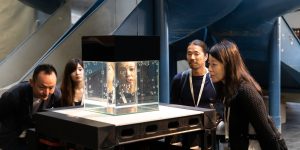
(un)shaped
Takayuki Hirai (JP), Yasuaki Kakehi (JP)
This installation utilizes antibubbles in water as a medium. Through computationally controlled droplets, the antibubbles form various patterns on the water’s surface. Then they start to float in the water and disappear after a while. These periodic phenomena shows continuous morphing from computationally controlled forms to organic ones mediated by the environment.
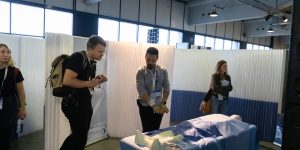
SimCath
Fernando Bello (MX), ICCESS & Salomé Bazin (FR), Cellule studio
How do surgeons prepare for an operation, when they know that the smallest mistake could be the line between life and death? That was the question Cellule faced when developing SimCath, a cardiology suite for simulation training. By training in a simulation environment, future surgeons have an opportunity to rehearse for complex surgery, performing common interactions between patients and clinicians in a low risk environment. Developing SimCath was reminiscent of building a theatre set, a stage which mimics the real surgical environment in such a way that the surgeons acting through their roles are immersed in the performance of surgery and the relationship between patients and clinicians.

Re-FREAM
STARTS Lighthouse
Re-FREAM is an invitation to artists and designers to re-think the future of fashion with state-of-the-art production technologies. Re-FREAM gives artists and designers access to new production technology, new materials, and know-how to co-create innovative fashion concepts in collaboration with scientists. Apply to the second call, opened on July 1, 2020.
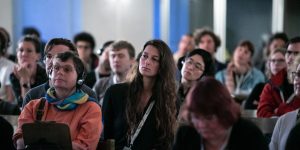
Panel I: Homo Deus
Renata Schmidtkunz (DE), Josef Penninger (AT), Sophie Wennerscheid (DE)
Renata Schmidtkunz hosts four panel discussions in the summer refectory, prominently featuring Josef Penninger, Sophie Wennerscheid, Oliviero Toscani, Amanda Cox, Markus Poschner, and others. The topic is dedicated to the role of science and research, which initially had to confirm a religious view of the world, then was subordinated to economic rationality, and now, in the dawning age of AI, is reorienting again. Social acceptance in relation to current AI research will be discussed. Another focal point of the panels will be the new artistic possibilities opening up due to AI applications, which also lead to a variety of novel business models or issues with copyright regulations.
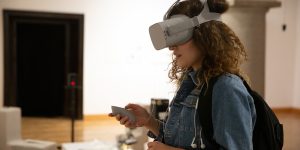
microplastic_hyperobject
Maria Degand (FR/DE), Leon-Etienne Kühr (DE)
Numbers and graphs are the essence of most scientific papers. They try to describe the world, facts, and problems. Microplastics are one of these problems. This artistic research is an example of how people can literally be put in these graphs. It looks at the real problem particle in this particle system. The design of experimental research is set up to simulate the experience of the hyperobject in virtual reality. Experiments on the scale in virtual reality and about connections in virtual space.
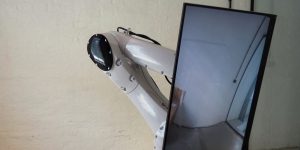
the shell
Amir Bastan (IR), Johannes Braumann (AT)
the shell constructs a narrative on both sides of a monitor, behind which something is hidden. This is caused by the observation in front of the monitor.
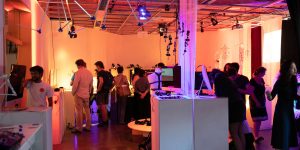
Content One Campus – Network Intelligence
Organized by Ministry of Culture, Sports and Tourism of the Republic of Korea (MCST) and Korea Creative Content Agency (KOCCA) (KR)
With its disruptive AI, robot, data, 3D, and VR technologies, the Fourth Industrial Revolution has triggered a fundamental change in the way we live, work and relate to one another. The speed and breadth of the economic, political, social, and cultural changes produced by technology are literally beyond our comprehension. It is time to think, act, and collaborate to bring about new methodologies for the coming age. What, then, will be the best strategic approach? What manners of collaboration are necessary? How can we educate our talented creators?
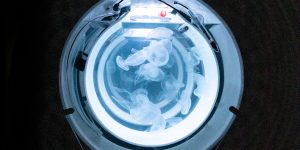
Aurelia 1 +Hz / proto viva generator
Robertina Šebjanič (SI)
Aurelia 1+Hz / proto viva generator addresses the possibilities of coexistence of animals and machines. The project uses living organisms to process “aliveness” of a simple robotic machine. The two entities – jellyfish and robot – are separated. If they merge into one, causing new biocybernetic organism to occur, would they be able to live forever?

The Beep Electronic Art Collection, Reus
The objective of the Beep Electronic Art Collection is to be witness and agent of the transgression created at the intersection of art, science and technology. It is recognized not only for what it collects, but for how it does so; it has generated a new type of collectionism promoting programs of production, preservation and patronage of technological art, encouraging the debate around issues related to the introduction of new technologies in art.


